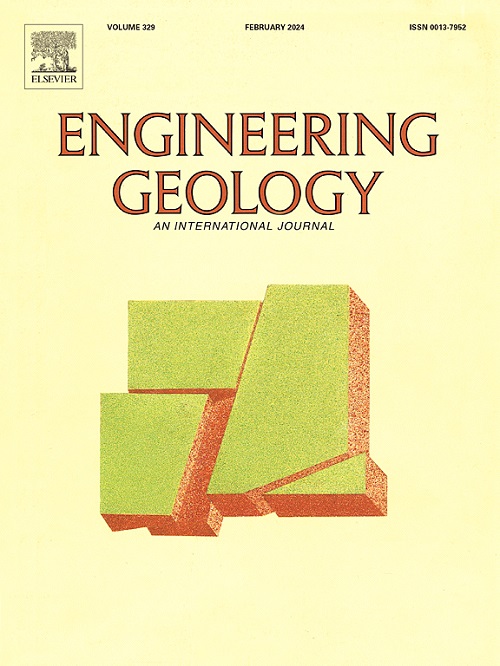循环剪切作用下单裂隙非达西渗流分析
IF 8.4
1区 工程技术
Q1 ENGINEERING, GEOLOGICAL
引用次数: 0
摘要
岩石裂隙中的流体流动受到循环剪切的显著影响。这种现象是由于地震活动或开挖、爆破和操作荷载引起的反复应力变化而产生的。在本研究中,通过实验研究了循环剪切后单个粗糙裂缝中的非达西流动。分析了惯性和粘性渗透率的演化规律,建立了非达西渗流的预测模型。首先进行了循环剪切实验,研究了剪切特征和几何变化,使用了四组包括24个粗糙岩石裂缝。随后,进行了360次非达西流动实验,研究了循环剪切作用下惯性和粘性渗透率的演化规律。随着剪切循环次数的增加,两种类型的渗透率都趋于降低。最显著的减少发生在第一个周期,随后是一个缓慢的下降,最终稳定下来。然后,考虑剪切前的几何形状、岩石特性和循环剪切特性,开发了非达西流动的预测模型。用实验数据对该模型进行了验证。在此基础上,提出了一种确定剪切循环临界次数的方法。这些发现有助于理解受地震活动或反复应力变化影响的裂缝中非达西流体的演化。本文章由计算机程序翻译,如有差异,请以英文原文为准。
Analysis of non-darcian flow in single rock fractures after cyclic shear
Fluid flow in rock fractures is significantly influenced by cyclic shear. This phenomenon arises due to seismic activity or repeated stress changes resulting from excavation, blasting, and operational loads. In this study, experiments are carried out to investigate non-Darcian flow in single rough fractures after cyclic shearing. The evolution of inertial and viscous permeability is analyzed, and a predictive model for non-Darcian flow is established. Cyclic shearing experiments are first conducted to examine shear characteristics and geometric variations, using four groups comprising 24 rough rock fractures. Subsequently, 360 non-Darcian flow experiments are performed to study the evolution of inertial and viscous permeability under cyclic shearing. It is observed that both types of permeability tend to decrease with an increasing number of shearing cycles. The most significant reduction occurs during the first cycle, followed by a slower decline that eventually stabilizes. A predictive model for non-Darcian flow is then developed, considering the geometry before shearing, rock properties, and cyclic shear characteristics. This model is validated against experimental data. Based on the proposed predictive model, a method for determining the critical number of shear cycles is also proposed. These findings contribute to understanding the evolution of non-Darcian flow in fractures subjected to seismic activity or repeated stress changes.
求助全文
通过发布文献求助,成功后即可免费获取论文全文。
去求助
来源期刊

Engineering Geology
地学-地球科学综合
CiteScore
13.70
自引率
12.20%
发文量
327
审稿时长
5.6 months
期刊介绍:
Engineering Geology, an international interdisciplinary journal, serves as a bridge between earth sciences and engineering, focusing on geological and geotechnical engineering. It welcomes studies with relevance to engineering, environmental concerns, and safety, catering to engineering geologists with backgrounds in geology or civil/mining engineering. Topics include applied geomorphology, structural geology, geophysics, geochemistry, environmental geology, hydrogeology, land use planning, natural hazards, remote sensing, soil and rock mechanics, and applied geotechnical engineering. The journal provides a platform for research at the intersection of geology and engineering disciplines.
 求助内容:
求助内容: 应助结果提醒方式:
应助结果提醒方式:


